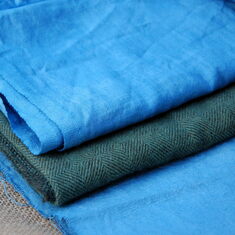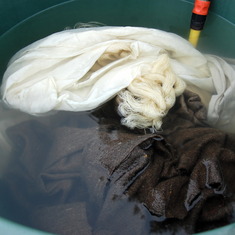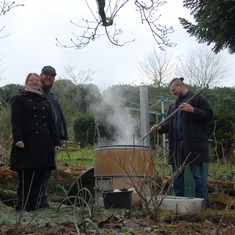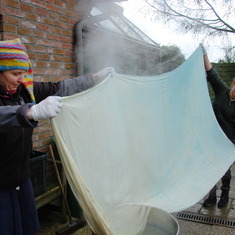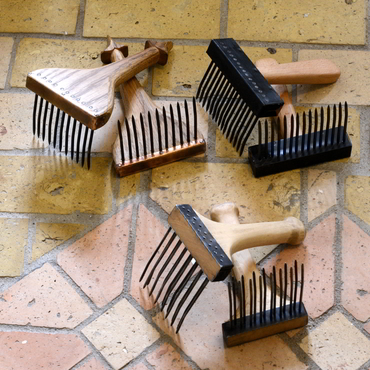Indigo...
But before we dyed Indigo directly on valuable, large pieces of fabric for the first time, we made a small dyeing experiment about a week before. The recipe for the indigo mixture was taken from Flinkhand, but instead of hydrosulfite we took sodium dithionite. In addition, we aimed at a lighter woad-blue, so we used only 10g of indigo instead of the 20g. For dyeing we had several 60m strands of fine wool yarn, a 100g strand of white and a 100g strand of natural brown yarn.
To our surprise, we soon discovered that the dye outperformed our expectations. Instead of a light blue we got a very strong blue.And the following yarns just did not want to get lighter. Not wanting to waste the remaining dye, we searched for things we could dye in the 15L pot. Another white and two natural dark brown yarns had to serve as well as a piece of linen and two pieces of wool. But we still didn't use all the indigo dye since we wanted to have some yarn and fabric left for the main event. Unfortunately, the pieces of fabric got somewhat patchy because the pot's volume was too small to stir properly. Luckily, this does not show that much on the two-tone woven diamond twill which we previously had dyed a light yellow.
At the dyeing event we had several meters of linen, wool and raw silk as well as some yarns for the indigo dyeing ready. With so much more fabric we had to take more indigo than with the sample dyeing - instead of 10g we took 20g. The first fabric, a piece of linen, actually received the color tone we imagined. Next we dyed a 2x1.5m piece of woollen lozenge twill. Not only did this turn out to be almost spotless, the wool fabric took on the color even better than the linen, so we got a rich royal blue. This fabric quickly became the object of the desire of some fellow dyers present..
A piece of raw silk several meters long then drew so much dye from that the following yarns and fabrics became significantly lighter. A two-tone woven diamond twill turned into a beautiful gray blue, for the remaining yarns and fine fabrics only a touch of blue was left. Part of this we will probably over-dye again on occasion. The fabrics are very fine and smooth (worsted yarn) and could be sold as beautiful veils with a gentle blue tone.
... onion skins...
We already have plenty of experience with the onion skins, the main thing being to keep the fire hot and to stir it. We had planned about 1100g of wool to be dyed in the first bath, which would have meant about 770g onion skins. We had collected about 850g of skins and decided not to be so greedy - all of the skins went into the pot. A fine 2/2 twill and some woollen yarn became so orange that one might think we cheated with madder. The second bath was then a bit more moderate and the typical onion golden yellow finally came with the 3rd bath. Two days after the actual dyeing event, we still had some dye left in the water, with which we dyed a coarse, gray 2/2 twill.
... and an awful lot of work
One can be surprised about how much work such a dyeing day actually is. We started with the preparations at about 10 o'clock in the morning (heating the water with the onion skins, soaking the things we wanted to dye, mixing the chemicals for the indigo bath etc.). Soon, the people we invited arrived as well. It seems that we didn't prepare everything as well as it should have been - from time to time there was some confusion about which fabric we wanted to dye next, where thing XY was again, who was supposed to do what and when and where.
Fortunately, this settled after some time and everyone at least looked as if (s)he did something productive, like stirring in the dye bath, helping to unfold the freshly dyed indigo fabrics (which always produced a lot of awe when it turned from practically no colour at all to a beautiful blue), playing with the kid, tending the barbecue, or doing proper German work: standing there, with a drink in one hand, giving random, helpful (?) remarks about the other people's work.
All in all, we had beautiful results and a great day. Thank you all for coming, sharing your time and thoughts and enjoying the fresh and shiny colours!
